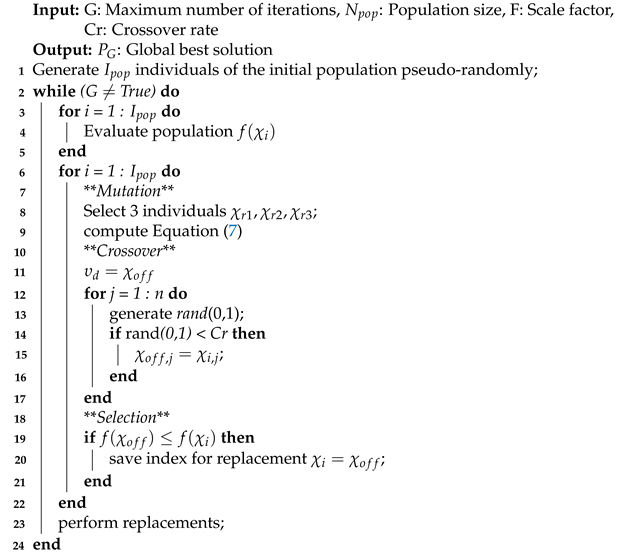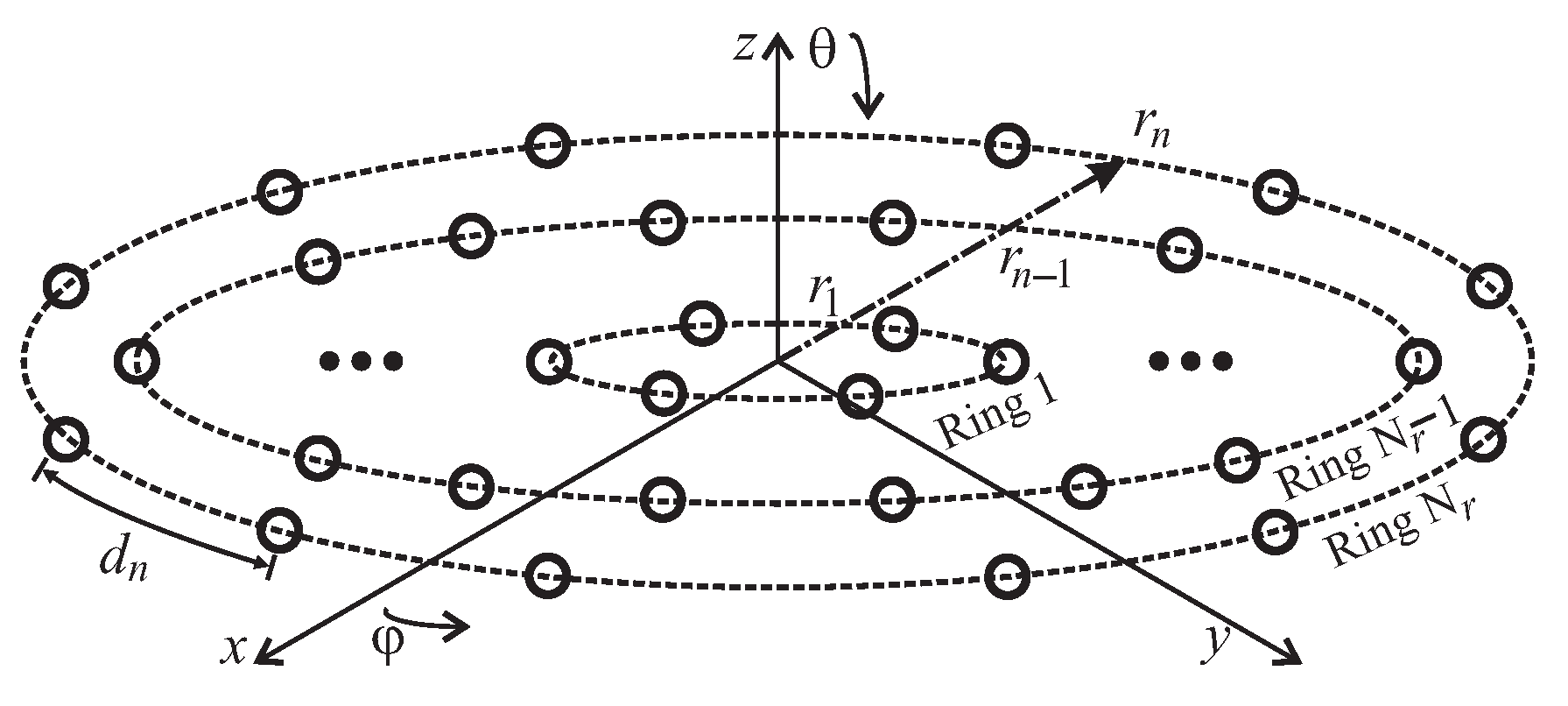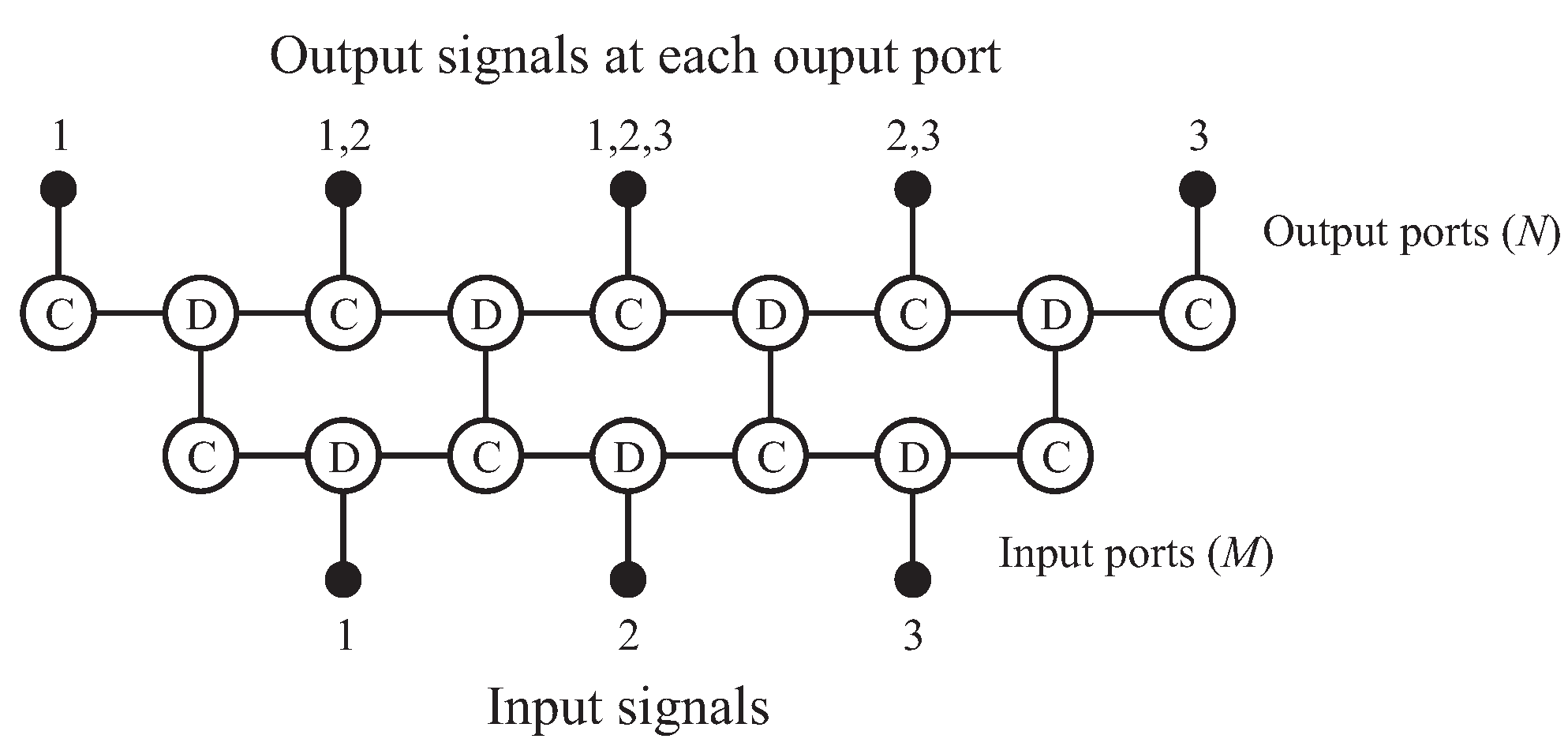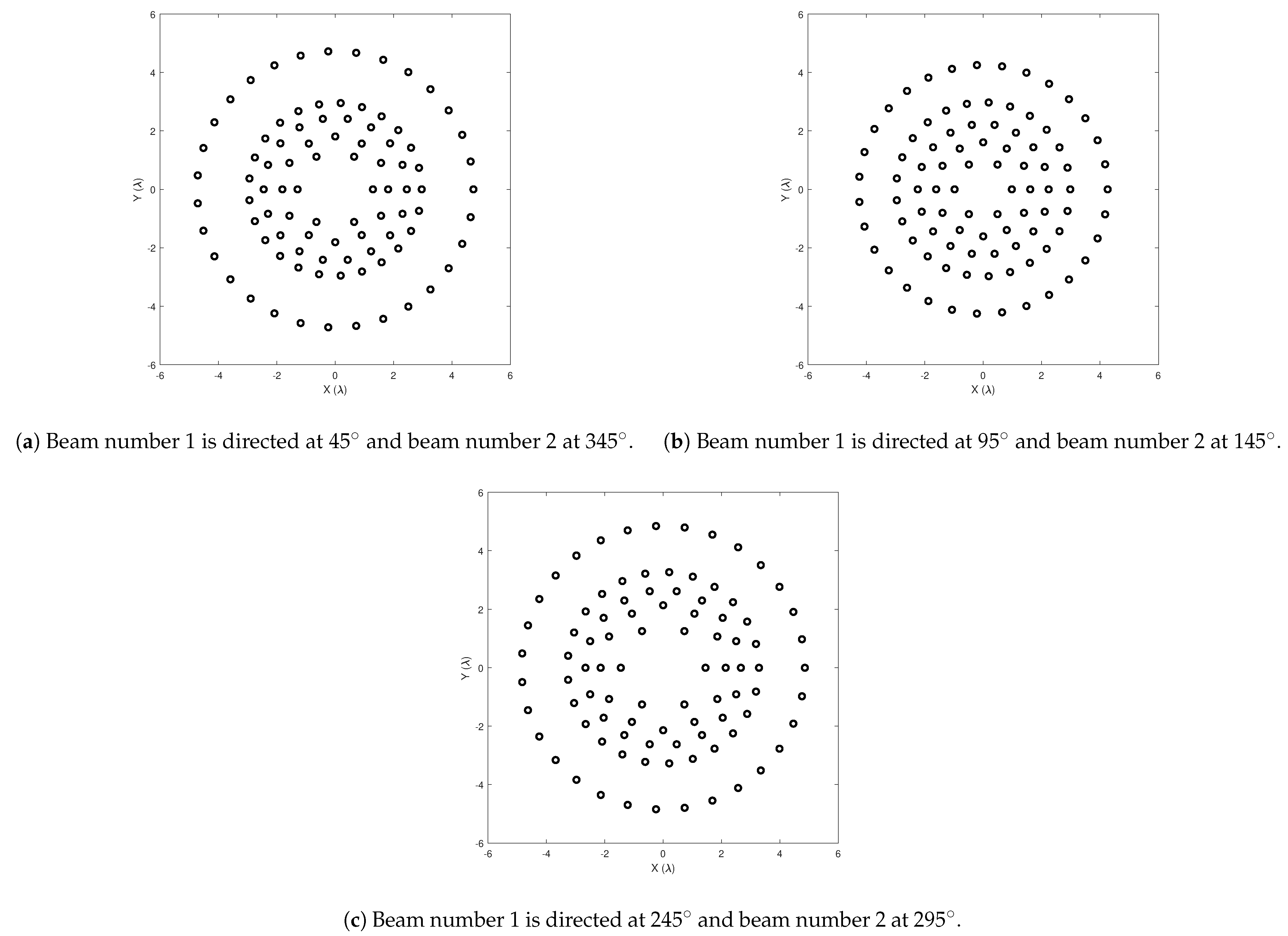Optimization of a Coherent Dual-Beam Array Feed Network for Aperiodic Concentric Ring Antennas
Abstract
:1. Introduction
2. Problem Formulation
2.1. Aperiodicity in Concentric Ring Arrays
2.2. Coherent BFN Model
2.3. Optimization Tool
| Algorithm 1: DE/rand/1/bin pseudocode used in the optimization process |
 |
3. Numerical Results
4. Conclusions
Author Contributions
Funding
Data Availability Statement
Conflicts of Interest
References
- Blake, J.; Nygren, E.; Schennum, G. Beamforming networks for spacecraft antennas. In 1984 Antennas and Propagation Society International Symposium; IEEE: Piscataway, NJ, USA, 1984; Volume 22, pp. 158–161. [Google Scholar] [CrossRef]
- Anguera, J.; Andújar, A.; Jayasinghe, J. High-Directivity Microstrip Patch Antennas Based on TModd-0 Modes. IEEE Antennas Wirel. Propag. Lett. 2020, 19, 39–43. [Google Scholar] [CrossRef]
- Laue, H.E.A.; du Plessis, W.P. Numerical Optimization of Compressive Array Feed Networks. IEEE Trans. Antennas Propag. 2018, 66, 3432–3440. [Google Scholar] [CrossRef] [Green Version]
- Dorrah, A.H.; Eleftheriades, G.V. Peripherally Excited Phased Array Architecture for Beam Steering with Reduced Number of Active Elements. IEEE Trans. Antennas Propag. 2020, 68, 1249–1260. [Google Scholar] [CrossRef]
- Lin, C.-C.; Tzuang, C.-K.C. A dual-beam micro-CPW leaky-mode antenna. IEEE Trans. Antennas Propag. 2000, 48, 310–316. [Google Scholar] [CrossRef]
- Floc’h, J.M.; El Sayed Ahmad, A.; Kokar, Y. Dual-Beam Antenna Design for Autonomous Sensor Network Applications. Int. J. Antennas Propag. 2012, 2012, 289681. [Google Scholar] [CrossRef]
- Deng, C.; Yu, W.; Lv, X. All-metallic dual-beam antenna with a low profile. In Proceedings of the 2017 IEEE International Symposium on Antennas and Propagation, and USNC/URSI National Radio Science Meeting, San Diego, CA, USA, 9–14 July 2017; pp. 2121–2122. [Google Scholar] [CrossRef]
- Hakimi, A.M.; Oraizi, H.; Keivaan, A.; Amini, A. Wideband Vertically Polarized Dual-Beam Antenna Using Modulated Metasurfaces. In Proceedings of the 14th European Conference on Antennas and Propagation (EuCAP 2020), Copenhagen, Denmark, 15–20 March 2020; pp. 4–8. [Google Scholar] [CrossRef]
- Xi, R.; Ang, S.; Porter, K.; Li, L. Generation of dual-beam orbital angular momentum vortex beam using transmit arrays. In Proceedings of the 2019 IEEE International Symposium on Antennas and Propagation, and USNC/URSI Radio Science Meeting, Atlanta, GA, USA, 7–12 July 2019; pp. 993–994. [Google Scholar] [CrossRef]
- Verevkin, A.P.; Kirillov, V.V.; Munina, I.V.; Turalchuk, P.A. Dual-beam Transmitarray for High Capacity Wireless Communication Systems. In Proceedings of the 2020 IEEE Conference of Russian Young Researchers in Electrical and Electronic Engineering (EIConRus 2020), Moscow, Russia, 27–30 January 2020; pp. 84–86. [Google Scholar] [CrossRef]
- Nikfalazar, M.; Sazegar, M.; Mehmood, A.; Wiens, A.; Friederich, A.; Maune, H.; Binder, J.R.; Jakoby, R. Two-Dimensional Beam-Steering Phased-Array Antenna With Compact Tunable Phase Shifter Based on BST Thick Films. IEEE Antennas Wirel. Propag. Lett. 2017, 16, 585–588. [Google Scholar] [CrossRef]
- Liu, S.; Chen, Q. Dual-Beam Gain-Reconfigurable Antennas Using A Shared Reflectarray Aperture. In Proceedings of the 2019 International Symposium on Antennas and Propagation (ISAP)-Proceedings, Xi’an, China, 27–30 October 2019; pp. 1–3. [Google Scholar]
- Chou, H.; Jian, H. Numerical design of dual-beam open-end waveguide antenna array for the angular diversity at millimeter waves. In Proceedings of the 2016 Asia-Pacific International Symposium on Electromagnetic Compatibility (APEMC 2016), Shenzhen, China, 17–21 May 2016; Volume 1, pp. 118–120. [Google Scholar] [CrossRef]
- Kodgirwar, V.P.; Deosarkar, S.B.; Joshi, K.R. Design of Dual-Band Beam Switching Array for Adaptive Antenna Applications Using Hybrid Directional Coupler and E-Shape Slot Radiator. Wirel. Pers. Commun. 2020, 113, 423–437. [Google Scholar] [CrossRef]
- Betancourt, D.; del Rio Bocio, C. A Novel Methodology to Feed Phased Array Antennas. IEEE Trans. Antennas Propag. 2007, 55, 2489–2494. [Google Scholar] [CrossRef]
- Betancourt, D.; del Rio, C. 3 by 3 phased array controlled by only three phase shifters. In Proceedings of the 2006 First European Conference on Antennas and Propagation, Nice, France, 6–10 November 2006; pp. 1–3. [Google Scholar] [CrossRef]
- Panduro, M.A.; del Rio-Bocio, C. Design of beam-forming networks using CORPS and evolutionary optimization. AEU Int. J. Electron. Commun. 2009, 63, 353–365. [Google Scholar] [CrossRef]
- Arce, A.; Covarrubias, D.H.; Panduro, M.A. Design of a multiple-beam forming network using CORPS optimized for cellular systems. AEU Int. J. Electron. Commun. 2012, 66, 349–356. [Google Scholar] [CrossRef]
- Saliani, N.; Bemani, M.; Kazemi, H. Modified CORPS beamforming network with null-steering capability. IET Microw. Antennas Propag. 2019, 13, 1208–1213. [Google Scholar] [CrossRef]
- Arce, A.; Stevens-Navarro, E.; Cardenas-Juarez, M.; Pineda-Rico, U.; Covarrubias, D.H. A Coherent Multiple Beamforming Network for a Non-uniform Circular Antenna Array. Radioengineering 2019, 27, 74–83. [Google Scholar] [CrossRef]
- Arce, A.; Stevens-Navarro, E.; Cardenas-Juarez, M.; Pineda-Rico, U.; Simon, J.; Panduro, M.A. Design and Optimization of a Coherent Beamforming Network for an Aperiodic Concentric Ring Array. Int. J. Antennas Propag. 2019, 2019, 1–10. [Google Scholar] [CrossRef] [Green Version]
- Balanis, C.A. Antenna Theory: Analysis and Design, 3rd ed.; John Wiley & Sons: New York, NY, USA, 2005. [Google Scholar]
- Haupt, R.L. Optimized element spacing for low sidelobe concentric ring arrays. IEEE Trans. Antennas Propag. 2008, 56, 266–268. [Google Scholar] [CrossRef]
- Salas-Sanchez, A.A.; Fondevila-Gomez, J.; Rodriguez-Gonzalez, J.A.; Ares-Pena, F.J. Parametric Synthesis of Well-Scanning Isophoric Pencil Beams. IEEE Trans. Antennas Propag. 2017, 65, 1422–1427. [Google Scholar] [CrossRef]
- Bencivenni, C.; Ivashina, M.V.; Maaskant, R. Reconfigurable aperiodic array synthesis by Compressive Sensing. In Proceedings of the 2016 10th European Conference on Antennas and Propagation (EuCAP), Davos, Switzerland, 10–15 April 2016; pp. 1–3. [Google Scholar] [CrossRef] [Green Version]
- Fonseca, N.J.G. Design and implementation of a closed cylindrical BFN-fed circular array antenna for multiple-beam coverage in Azimuth. IEEE Trans. Antennas Propag. 2012, 60, 863–869. [Google Scholar] [CrossRef]
- Rotman, R.; Tur, M.; Yaron, L. True Time Delay in Phased Arrays. Proc. IEEE 2016, 104, 504–518. [Google Scholar] [CrossRef]
- Zaker, R.; Abdipour, A.; Tavakoli, A. Full-wave simulation, design and implementation of a new combination of antenna array feed network integrated in low profile microstrip technology. Analog. Integr. Circuits Signal Process. 2014, 80, 507–517. [Google Scholar] [CrossRef]
- Ferrando, N.; Fonseca, N.J.G. Investigations on the efficiency of array fed coherently radiating periodic structure beam forming networks. IEEE Trans. Antennas Propag. 2011, 59, 493–502. [Google Scholar] [CrossRef]
- Deb, A.; Roy, J.S.; Gupta, B. A Differential Evolution Performance Comparison: Comparing How Various Differential Evolution Algorithms Perform in Designing Microstrip Antennas and Arrays. IEEE Antennas Propag. Mag. 2018, 60, 51–61. [Google Scholar] [CrossRef]
- Eltaeib, T.; Mahmood, A. Differential evolution: A survey and analysis. Appl. Sci. 2018, 8, 1945. [Google Scholar] [CrossRef] [Green Version]
- Opara, K.R.; Arabas, J. Differential Evolution: A survey of theoretical analyses. Swarm Evol. Comput. 2019, 44, 546–558. [Google Scholar] [CrossRef]
- Neri, F.; Tirronen, V. Recent advances in differential evolution: A survey and experimental analysis. Artif. Intell. Rev. 2010, 33, 61–106. [Google Scholar] [CrossRef]





| Antenna System | Number of | Main Beam | ACRA + CBFN Improvement | |||
|---|---|---|---|---|---|---|
| (Array + CBFN) | Beam | Direction | SLL [dB] | D [dB] | SLL [dB] | D [dB] |
| Uniform | 1 and 2 | −14.49 | 15.35 | − | − | |
| Multi−beam (Opt. ) | 1 | 45° | −19.67 | 17.89 | −6.2 | 3.2 |
| 95° | −17.40 | 17.78 | −4.7 | 2.5 | ||
| 245° | −20.46 | 18.88 | −6.1 | 3.5 | ||
| 2 | 345° | −17.59 | 16.12 | −3.0 | 0.9 | |
| 145° | −16.74 | 16.65 | −2.2 | 1.3 | ||
| 295° | −16.86 | 17.27 | −2.3 | 1.9 | ||
Publisher’s Note: MDPI stays neutral with regard to jurisdictional claims in published maps and institutional affiliations. |
© 2021 by the authors. Licensee MDPI, Basel, Switzerland. This article is an open access article distributed under the terms and conditions of the Creative Commons Attribution (CC BY) license (http://creativecommons.org/licenses/by/4.0/).
Share and Cite
Arce, A.; Stevens-Navarro, E.; Pineda-Rico, U.; Cardenas-Juarez, M.; Castillo-Soria, F.R.; Covarrubias, D.H. Optimization of a Coherent Dual-Beam Array Feed Network for Aperiodic Concentric Ring Antennas. Appl. Sci. 2021, 11, 1111. https://doi.org/10.3390/app11031111
Arce A, Stevens-Navarro E, Pineda-Rico U, Cardenas-Juarez M, Castillo-Soria FR, Covarrubias DH. Optimization of a Coherent Dual-Beam Array Feed Network for Aperiodic Concentric Ring Antennas. Applied Sciences. 2021; 11(3):1111. https://doi.org/10.3390/app11031111
Chicago/Turabian StyleArce, Armando, Enrique Stevens-Navarro, Ulises Pineda-Rico, Marco Cardenas-Juarez, Francisco R. Castillo-Soria, and David H. Covarrubias. 2021. "Optimization of a Coherent Dual-Beam Array Feed Network for Aperiodic Concentric Ring Antennas" Applied Sciences 11, no. 3: 1111. https://doi.org/10.3390/app11031111







